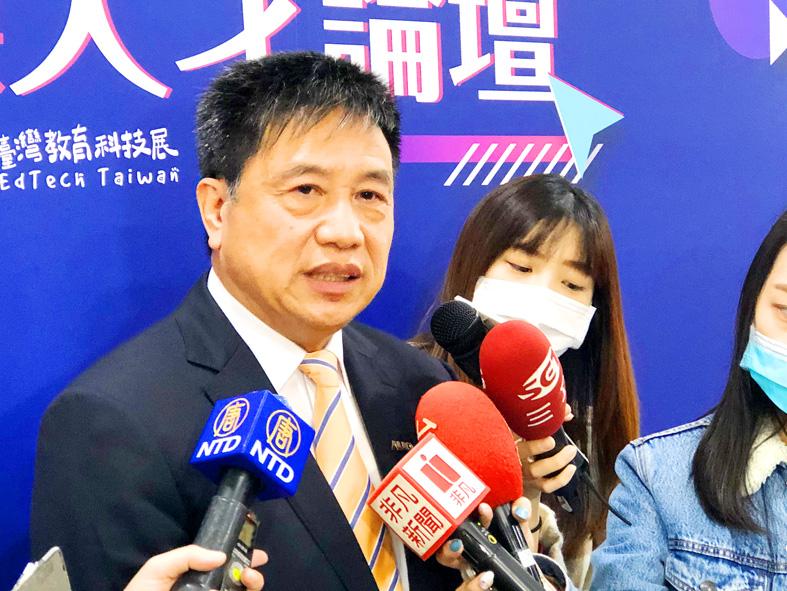AU Optronics Corp (AUO, 友達光電) yesterday said that net profit last quarter more than halved from a quarter earlier due to excessive channel inventory and it expects demand to dwindle further this quarter as consumer spending on TVs and other consumer electronics slows amid rising living costs.
Russia’s invasion of Ukraine has driven up prices for energy and key commodities, stoking concern about inflation risks and dampening consumer demand for TVs and information technology (IT) products, the Hsinchu-based panel maker said.
As a result, some customers have prioritized inventory digestion and slowed orders, causing average selling prices (ASP) of AUO products to drop at a quarterly pace of 6.28 percent last quarter, it said.

Photo: CNA
Net profit plummeted 51.5 percent to NT$5.16 billion (US$176.05 million) last quarter, compared with NT$10.66 billion a quarter earlier, the lowest in six quarters.
Net profit in the first quarter plummeted 56.38 percent from NT$11.83 billion a year earlier.
Gross margin decreased to 14.3 percent from 18.9 percent the previous quarter and 22 percent a year earlier.
AUO said that order visibility is not clear and time is needed for customers to reduce channel inventory to a healthy level given macroeconomic uncertainties, COVID-19 lockdowns in China and the war in Ukraine.
Against this backdrop, “AUO will adjust its equipment loading rate in accordance with market changes,” company chairman Paul Peng (彭双浪) told an online investors’ conference. “TVs and consumer IT products are to be affected more significantly.”
AUO’s factory utilization rate fell to below 90 percent last quarter, the company said.
Shipments this quarter are expected to dip by a low single-digit percentage from last quarter, while ASP would go down by a high single-digit percentage, it said.
Large lockdowns in China have reduced AUO’s production by between 30 percent and 40 percent at its plant in Kunshan, one of its major manufacturing sites for high-end notebook computer panels.
The company’s capacity expansion plan at the Kunshan plant was hampered by COVID-19 restrictions, with equipment and workers barred from entering the city, while the restrictions have also snarled transportation, driven up logistics costs and created a new squeeze on supply chains, Peng said.
“Don’t be surprised if I tell you we are short of carton boxes and packaging tape to ship our products,” Peng said. “Supply chain management becomes crucial.”
There is brisk demand for commercial notebook computers, niche products and tailor-made panels, including those used in vehicles, industrial devices and medical devices, which are less sensitive to industrial cycles.
Automotive panels accounted for 9 percent of the company’s total revenue of NT$81.53 billion last quarter. TV panels made up 17 percent. Panels used in monitors, notebook computers and mobile phones contributed 46 percent.

TAKING STOCK: A Taiwanese cookware firm in Vietnam urged customers to assess inventory or place orders early so shipments can reach the US while tariffs are paused Taiwanese businesses in Vietnam are exploring alternatives after the White House imposed a 46 percent import duty on Vietnamese goods, following US President Donald Trump’s announcement of “reciprocal” tariffs on the US’ trading partners. Lo Shih-liang (羅世良), chairman of Brico Industry Co (裕茂工業), a Taiwanese company that manufactures cast iron cookware and stove components in Vietnam, said that more than 40 percent of his business was tied to the US market, describing the constant US policy shifts as an emotional roller coaster. “I work during the day and stay up all night watching the news. I’ve been following US news until 3am

UNCERTAINTY: Innolux activated a stringent supply chain management mechanism, as it did during the COVID-19 pandemic, to ensure optimal inventory levels for customers Flat-panel display makers AUO Corp (友達) and Innolux Corp (群創) yesterday said that about 12 to 20 percent of their display business is at risk of potential US tariffs and that they would relocate production or shipment destinations to mitigate the levies’ effects. US tariffs would have a direct impact of US$200 million on AUO’s revenue, company chairman Paul Peng (彭雙浪) told reporters on the sidelines of the Touch Taiwan trade show in Taipei yesterday. That would make up about 12 percent of the company’s overall revenue. To cope with the tariff uncertainty, AUO plans to allocate its production to manufacturing facilities in

Six years ago, LVMH’s billionaire CEO Bernard Arnault and US President Donald Trump cut the blue ribbon on a factory in rural Texas that would make designer handbags for Louis Vuitton, one of the world’s best-known luxury brands. However, since the high-profile opening, the factory has faced a host of problems limiting production, 11 former Louis Vuitton employees said. The site has consistently ranked among the worst-performing for Louis Vuitton globally, “significantly” underperforming other facilities, said three former Louis Vuitton workers and a senior industry source, who cited internal rankings shared with staff. The plant’s problems — which have not

TARIFF CONCERNS: The chipmaker cited global uncertainty from US tariffs and a weakening economic outlook, but said its Singapore expansion remains on track Vanguard International Semiconductor Corp (世界先進), a foundry service provider specializing in producing power management and display driver chips, yesterday withdrew its full-year revenue projection of moderate growth for this year, as escalating US tariff tensions raised uncertainty and concern about a potential economic recession. The Hsinchu-based chipmaker in February said revenues this year would grow mildly from last year based on improving supply chain inventory levels and market demand. At the time, it also anticipated gradual quarter revenue growth. However, the US’ sweeping tariff policy has upended the industry’s supply chains and weakened economic prospects for the world economy, it said. “Now